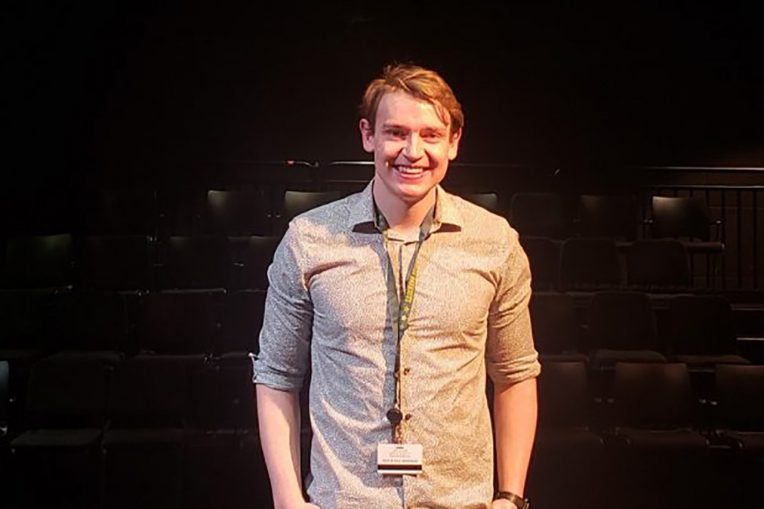An average weekday for an undergraduate student may include attending classes, grabbing some lunch, or maybe a quick study session before an exam. For Chris Turner a typical Tuesday might just mean a trip to space—alongside 40 sixth graders, of course.
Last spring Turner, a senior theatre teacher education major and math minor from Lombard, received an Undergraduate Student Research Program grant (renamed the FIREbird grant) for his research on the effects of theatre arts integration. This teaching approach engages students by bringing theatrical elements into the classroom.
“My research was based in creative drama,” Turner said. “Instead of doing a play, where you have the audience on one side and the performers on the other, you mix it up and everybody imagines this fake world together.”
Appears InA frequent destination for Turner’s in-class imagination sessions was outer space. The variables at play in a trip to space offered stimulating material he could use in the subject of his teaching: math.
“Math seemed like a really good place for arts integration to come in because a lot of people don’t enjoy math, or they aren’t confident in math. A lot of people don’t really understand why they’re learning math, and that’s really a challenge for elementary math teachers,” Turner said.
Turner investigated the effects of arts integration by studying how students’ feelings of motivation, perception, and enjoyment affect the learning process. In other words, Turner’s work asked participants to reflect on the question: “How do I feel when I study math?”
Research literature that Turner examined early in his project pointed to a correlation between enjoying math and understanding the subject. This highlighted the potential positive impacts incorporating theatrical practices could have on student learning.
In December 2021 Turner led sixth-grade math classes at the Metcalf School using lesson plans that included story drama and scene development as theatrical techniques that would aid in translating course material.
“We’d start with drawing a rocket ship. So everyone comes up and draws a single rocket ship, but then we’d need to create it with blocks in real life and all the angles need to match up. Then we need to figure out, ‘Do we have enough fuel to get where we’re going?’” Turner said. “So we would just go through the imagined world, and the math presented itself.”
“Everybody can learn math. It’s just about opportunity and effort.”
Chris Turner
After the lessons, students were asked to evaluate their learning experience on a 1–5 Likert scale, rating their confidence, motivation, and enjoyment of math as well as their perceived value of the subject during the arts-integrated lesson. “One” indicated that the student strongly disagreed that the lesson improved a given aspect of their learning while a “5” indicated they strongly agreed the lesson improved their learning.
Survey results from the 40 students showed a strong correlation between the arts-integrated lesson and a positive student experience, with mean ratings for confidence, motivation, value, and enjoyment being 3.40, 3.90, 4.00, and 4.65, respectively.
The high ratings in value and enjoyment for the students confirmed Turner’s initial beliefs: “Everybody can learn math. It’s just about opportunity and effort.”
Dr. Jimmy Chrismon, an assistant professor of theatre teacher education, was the faculty advisor for Turner’s work. Acting as a guide and mentor for Turner throughout his research, Chrismon was proud to see the end result of Turner’s efforts.
“As a teacher of teachers, it’s really cool to see your students succeed and come out the other end having learned something and being a better teacher for it,” Chrismon said. “And I just think the world of Chris. He’s a wonderful human being on top of being extremely intelligent and creative. So to see all those worlds of his (theater and math) collide at the end of this project that was something he was so passionate about, as a teacher, there’s no greater thing.”
While the confirmation of his hypothesis was a rewarding experience for Turner, his favorite part of the research was seeing students get creative with their learning.
“I just had this experience with a student where, when we all went to space, the student was looking around and just said, ‘There’s Mars.’” Turner said. “You could see it in his eyes, he was seeing Mars.”

